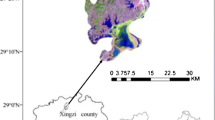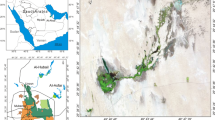Abstract
Wetlands provide a range of critically important ecosystem services. However, a lack of reliable wetland data limits the efficacy of wetland management in remote mountainous areas. To optimize the management of wetlands in the vicinity of Mount Everest we created a new classification system for high alpine wetlands. Object-oriented image classifications and geographical information systems were used to extract wetland information for 1976, 1988, and 2006 from remote sensing data and field surveys. The results show that total area of wetlands in the vicinity of Mount Everest in 2006 was 1663.5 km2 mainly found 4100–4800 m above sea level. Wetlands had changed, and the changing area (expansion and contraction) added up to 94.5 km2 or 5.6% from 1976–2006. Temporal-spatial variation in wetlands and land cover imply that regressive succession has occurred in some areas. Natural driving forces are key factors. Data suggest that creation of the Mount Qomolangma (Everest) National Nature Preserve in 1988 positively impacted wetland conservation.




Similar content being viewed by others
References
Bai JH, Ouyang H, Xu HF, Zhou CP, Qin G (2004) Advances in studies of wetlands in Qinghai-Tibet Plateau. Prog Geogr 23:1–9
Blaschke T (2010) Object based image analysis for remote sensing. ISPRS J Photogramm Remote Sens 65:2–16
Blaschke T, Hay GJ (2001) Object-oriented image analysis and scale-space: theory and methods for modeling and evaluating multiscale landscape structure. Int Arc Photogram Rem Sens 34:22–29
Bwangoy JB, Hansen MC, Roy DP, De Grandi G, Justice CO (2010) Wetland mapping in the Congo Basin using optical and radar remotely sensed data and derived topographical indices. Remote Sens Environ 114:73–86
Castañeda C, Ducrot D (2009) Land cover mapping of wetland areas in an agricultural landscape using SAR and Landsat imagery. J Environ Manag 90:2270–2277
Castañeda C, Herrero J (2008) Assessing the degradation of saline wetlands in an arid agricultural region in Spain. Catena 72:205–213
Cidanlunzhu (1997) Overview of Qomolangma National Nature Preserve. China Tibetology 21:3–22
Comprehensive Scientific Expedition Team of Chinese Academy of Sciences in Qinghai-Tibet Plateau (1988) Qinghai-Tibet Plateau scientific expedition series: Tibet vegetation. Science, Beijing
Cozar A, Garcia CM, Galvez JA, Loiselle SA, Bracchini L, Cognetta A (2005) Remote sensing imagery analysis of the lacustrine system of Ibera wetland (Argentina). Ecol Model 186:29–41
Davis TJ (1994) The Ramsar Convention manual: A guide to the convention on wetlands of international importance especially as waterfowl habitat. Ramsar Convention Bureau, Gland
Davranche A, Lefebvre G, Poulin B (2010) Wetland monitoring using classification trees and SPOT-5 seasonal time series. Remote Sens Environ 114:552–562
Duan KQ, Yao TD, Pu JC, Sun WZ (2002) Response of monsoon variability in Himalayas to global warming. Chin Sci Bull 47:1842–1845
Duan KQ, Thompson LG, Yao TD, Davis ME, Mosley-Thompson E (2007) A 1000 year history of atmospheric sulfate concentrations in southern Asia as recorded by a Himalayan ice core. Geophys Res Lett 34:L1810
Epting J, Verbyla D, Sorbel B (2005) Evaluation of remotely sensed indices for assessing burn severity in interior Alaska using Landsat TM and ETM+. Remote Sens Environ 96:328–339
Fox JL, Dhondup K, Dorji T (2009) Tibetan antelope Pantholops hodgsonii conservation and new rangeland management policies in the western Chang Tang Nature Reserve, Tibet: is fencing creating an impasse? Oryx 43:183–190
Frohn R, Reif M, Lane C, Autrey B (2009) Satellite remote sensing of isolated wetlands using object-oriented classification of Landsat-7 data. Wetlands 29:931–941
Gondwe B, Hong S, Wdowinski S, Bauer-Gottwein P (2010) Hydrologic dynamics of the ground-water-dependent Sian Ka’an wetlands, Mexico, derived from InSAR and SAR Data. Wetlands 30:1–13
Grapentine J, Kowalski K (2010) Georeferencing large-scale aerial photographs of a great lakes coastal wetland: a modified photogrammetric method. Wetlands 30:369–374
Hess LL, Melack JM, Novo EMLM, Barbosa CCF, Gastil M (2003) Dual-season mapping of wetland inundation and vegetation for the central Amazon basin. Remote Sens Environ 87:404–428
Jin XY, Paswaters S (2007) A fuzzy rule base system for object-based feature extraction and classification. Proc SPIE 6567:65671H
Jones K, Lanthier Y, van der Voet P, van Valkengoed E, Taylor D, Fernández-Prieto D (2009) Monitoring and assessment of wetlands using Earth Observation: The GlobWetland project. J Environ Manag 90:2154–2169
Kayranli B, Scholz M, Mustafa A, Hedmark Å (2010) Carbon storage and fluxes within freshwater wetlands: a critical review. Wetlands 30:111–124
Keith DA, Rodoreda S, Bedward M (2010) Decadal change in wetland-woodland boundaries during the late 20th century reflects climatic trends. Glob Chang Biol 16:2300–2306
Lang M, McCarty G (2009) LiDAR intensity for improved detection of inundation below the forest canopy. Wetlands 29:1166–1178
Li Z, Sun WX, Zeng QZ (1999) Deriving glacier change information on the Xizang (Tibetan) Plateau by integrating RS and GIS techniques. Acta Geographica Sinica 54:263–268
Liu K, Li X, Shi X, Wang S (2008) Monitoring mangrove forest changes using remote sensing and GIS data with decision-tree learning. Wetlands 28:336–346
MacKay H, Finlayson CM, Fernández-Prieto D, Davidson N, Pritchard D, Rebelo LM (2009) The role of Earth Observation (EO) technologies in supporting implementation of the Ramsar Convention on Wetlands. J Environ Manag 90:2234–2242
McCarthy T, Tooth S, Kotze D, Collins N, Wandrag G, Pike T (2010) The role of geomorphology in evaluating remediation options for floodplain wetlands: the case of Ramsar-listed Seekoeivlei, eastern South Africa. Wetl Ecol Manag 18:119–134
McFeeters SK (1996) The use of the Normalized Difference Water Index (NDWI) in the delineation of open water features. Int J Remote Sens 17:1425–1432
Mitri GH, Gitas IZ (2004) A performance evaluation of a burned area object-based classification model when applied to topographically and non-topographically corrected TM imagery. Int J Remote Sens 25:2863–2870
Mitsch WJ, Gosselink JG (2000) The value of wetlands: importance of scale and landscape setting. Ecol Econ 35:25–33
Nie Y, Zhang YL, Liu LS, Zhang JP (2010) Glacial change in the vicinity of Mt. Qomolangma (Everest), central high Himalayas since 1976. J Geogr Sci 20:667–686
Niu ZG, Gong P, Cheng X, Guo J, Wang L, Huang H, Shen S, Wu Y, Wang X, Wang X, Ying Q, Liang L, Zhang L, Wang L, Yao Q, Yang Z, Guo Z, Dai Y (2009) Geographical characteristics of China’s wetlands derived from remotely sensed data. Science in China 52:723–738
Ozesmi SL, Bauer ME (2002) Satellite remote sensing of wetlands. Wetl Ecol Manag 10:381–402
Pan X, Wang B (2009) Time for China to restore its natural wetlands. Nature 459:321
Papastergiadou ES, Retalis A, Apostolakis A, Georgiadis T (2008) Environmental monitoring of spatio-temporal changes using remote sensing and GIS in a Mediterranean wetland of Northern Greece. Wat Resour Manag 22:579–594
Prigent C, Matthews E, Aires F, Rossow WB (2001) Remote sensing of global wetland dynamics with multiple satellite data sets. Geophys Res Lett 28:4631–4634
Qiu J (2008) The third pole. Nature 454:393–396
Radoux J, Defourny P (2007) A quantitative assessment of boundaries in automated forest stand delineation using very high resolution imagery. Remote Sens Environ 110:468–475
Ramsar Convention Secretariat (2006) The Ramsar Convention manual: a guide to the Convention on Wetlands (Ramsar, Iran, 1971), 4th edn. Ramsar Convention Secretariat, Gland
Reif M, Frohn RC, Lane CR, Autrey B (2009) Mapping isolated wetlands in a karst landscape: GIS and remote sensing methods. GISci Rem Sens 46:187–211
Shen SP, Wang J, You LJ, Yang MJ, Song Y, Jiang Y (2005) Remote sensing dynamic monitoring of the Zoige marsh wetland. Sichuan J Geology 25:119–121
Tibet Bureau of Statistic (2009) Tibet statistical yearbook. China Statistics, Beijing
Tibetan Scientific Expedition Team of Chinese Academy of Sciences (1975) Report of scientific expedition in Mt. Qomolangma (Everest) region 1966–1968 (Geography). Science, Beijing
Wang GX, Li YS, Wang YB, Chen L (2007) Typical alpine wetland system changes on the Qinghai-Tibet plateau in recent 40 years. Acta Geographica Sinica 62:481–491
Watts JD, Lawrence RL, Miller PR, Montagne C (2009) Monitoring of cropland practices for carbon sequestration purposes in north central Montana by Landsat remote sensing. Remote Sens Environ 113:1843–1852
Wright C, Gallant A (2007) Improved wetland remote sensing in Yellowstone National Park using classification trees to combine TM imagery and ancillary environmental data. Remote Sens Environ 107:582–605
Xie GD, Lu CX, Leng YF, Zheng D, Li SC (2003) Ecological assets valuation of the Tibetan Plateau. J Nat Resour 18:189–196
Yang YH, Piao SL (2006) Variations in grassland vegetation cover in relation to climatic factors on the Tibetan Plateau. J Plant Ecol 30:1–8
Yang XC, Zhang YL, Zhang W, Yan Y, Wang Z, Ding M, Chu D (2006) Climate change in Mt. Qomolangma region since 1971. J Geogr Sci 16:326–336
Yu RH, Li CY, Liu TX, Xu YP (2004) The environment evolution of Wuliangsuhai wetland. J Geogr Sci 14:456–464
Zhang W, Zhang YL, Wang ZF, Ding MJ, Yang XC, Lin XD, Liu LS (2007) Vegetation change in the Mt. Qomolangma Nature reserve from 1981 to 2001. J Geogr Sci 17:152–164
Zhang SQ, Na XD, Kong B, Wang Z, Jiang H, Yu H, Zhao Z, Li X, Liu C, Dale P (2009) Identifying wetland change in China’s Sanjiang Plain using remote sensing. Wetlands 29:302–313
Zhang YL, Wang CL, Bai WQ, Wang ZF, Tu YL, Yangjaen DG (2010) Alpine wetlands in the Lhasa River Basin, China. J Geogr Sci 20:375–388
Zhu WZ, Zhong XH, Fan JR (2003) Characteristics and conservational measures of wetlands ecosystem in Tibet. J Mt Sci 21:7–12
Acknowledgments
This study was jointly supported by the One Hundred Person Program, Chinese Academy of Sciences (grant 110900K242), National Basic Research Program of China (grant 2010CB951704), and the Strategic Advanced Sciences and Technology Program (grant XDA05050105) of the Chinese Academy of Sciences. Thanks to Rongfu Huang for help with species identification during field surveys. Thanks to Yili Zhang, Linshan Liu, Zhaofeng Wang, Qinqin Zhang, Yingying Wu, Xueru Zhang, and Jiping Zhang for advice on the study design and preparation of this manuscript.
Author information
Authors and Affiliations
Corresponding author
Additional information
An erratum to this article can be found at http://dx.doi.org/10.1007/s13157-011-0219-y
Rights and permissions
About this article
Cite this article
Nie, Y., Li, A. Assessment of Alpine Wetland Dynamics from 1976–2006 in the Vicinity of Mount Everest. Wetlands 31, 875–884 (2011). https://doi.org/10.1007/s13157-011-0202-7
Received:
Accepted:
Published:
Issue Date:
DOI: https://doi.org/10.1007/s13157-011-0202-7




